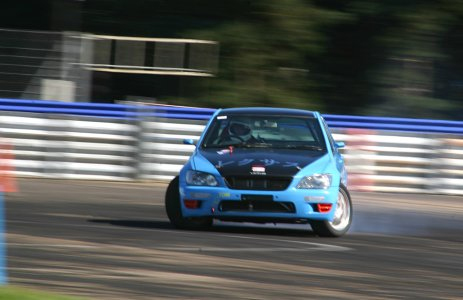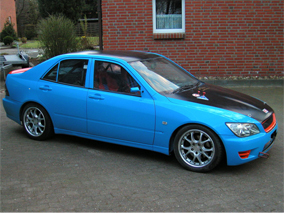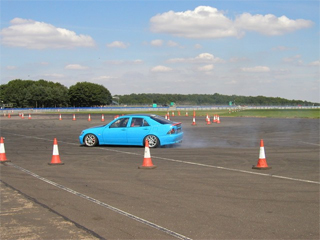 Drifting - explained! Drifting - explained!
A brief explanation of the popular 'drifting' by Matthew Clawley

History of Drifting
Where did it all start?!, The Japanese towns of Rokkosan, Hakone, Irohazaka and various hill climbs in Nagano are all steeped in legends of the origins of Drifting. No one can really pinpoint Drifting’s actual birth place but the movement started in the mid 1960’s. Like many forms of professional racing, the modern interpretation of drifting evolved from a form of illegal street racing held on windy mountain roads called ‘ Touge ‘. Touge was practised by extremely dedicated enthusiasts who’s only goal was to trim precious milliseconds off their time point to point. Eventually some of these drivers began to adopt driving techniques used by rally drivers, techniques to corner quickly without losing too much momentum.
As the drivers began to emulate the rally driver techniques, they discovered that not only did their times and driving performance improve but that it gave an exciting and intense drive – Drifting was born.
At the time that this technique became popular, drifters began to bring their sport to the towns and cities, adding their own flavour and flamboyant driving as well fantastic styling and outrageous vehicles. Eventually word spread and people began to form on the street to witness these amazing drivers and machines. But as popular Drifting had become, it was relegated to the underground scene due to the risks and image associated with illegal street contests.
Eventually the popularity of Drifting grew and competitors started organising their own events at local circuits, and off the streets. The events were fun to begin with however after time the drivers and skills became so refined that things got very competitive. From these events Video Option began to organise Driver Search events, held to allow the local driver to show off their skills and compete with each other. For a while the Driver Search events satisfied most but as skills and techniques improved, manufacturers began producing specific parts just for Drift and it was time to raise the bar on the events.
It was the vision of a car enthusiast and magazine publisher that brought Drifting to the mainstream motorsports in Japan. Mr Daijiro Inada, Founder of Option magazine and the Tokyo Auto Salon knew that the Driver Search events held a fraction of the potential that Drifting could generate and he felt strong about bringing the sport to a professional level. In 2001 with the help of Keiichi Tsuchiya, a professional Touring Car driver in Japan and the person he considered to be the father of modern Drifting, Daijiro created the D1 Grand Prix. Today in Japan the D1 Grand Prix is so popular that the drivers are now all well known celebrities. True to Daijiro’s vision, the D1 Grand Prix represents the highest level of the sport. Now established in Japan, D1is reaching out across the world, already holding events in the USA over the past 2 years and now in Europe too, with the collaboration of NRG Events Ltd, a UK company which formed the D1 Great Britain National Championship on behalf of the D1 Corporation. As well as Europe the D1 Corporation also have aspirations to hold events in Korea and further expand on the USA events with a World Series in mind for the future. D1 is now set to explode all over world!

The Drifting Movement Evolves
About the same time touge evolved into drifting, some of the rolling zoku came off the mountains to bring their new sport to the urban jungles of Japan. The urban drifters added their own flavour to the sport with their flamboyant driving style and outrageous vehicles. Eventually, word of the spectacle spread and fans began showing up to witness drifting's amazing drivers and machines. But as popular as drifting had become; it was relegated to underground status by the risks and image associated with illegal street contests.
Eventually, the popularity of drifting propelled the sport into the mainstream and competitors started to organize and take their home-grown trials to the track. The gatherings were originally just for fun until the cars and driving skills became so refined that things started to get competitive. From the initial organized trials, regional drift contest open to the public and professionally judged, known as ikaten created by Video-OPTION, were began all major cities of Japan. The Drivers Search events let local drivers of all backgrounds show off their skills and compete with each other. For awhile, Drivers Search events satisfied the thirst of drifting fans and drivers but as skills and techniques improved, and manufacturers started producing drifting-specific components, it was clearly time to raise the bar.
A Visionary
It was the vision of a car enthusiast and magazine publisher that brought drifting to mainstream motorsports in Japan.
Daijiro Inada, founder of Option Magazine and the Tokyo Auto Salon, knew drifting and the Drivers Search events represented only a fraction of the potential of drifting to the global motorsport subculture. Daijiro felt a strong need to bring drifting to a professional level.
In 2001, with the help of long time friend Keiichi Tsuchiya, a professional Touring Car driver and the person considered to be the father of modern competitive drifting, Daijiro created the D1 Grand Prix. Today, the D1 Grand Prix is so popular in Japan that D1 drivers are celebrities. True to Mr. Inada's vision, the D1 Grand Prix represents the highest level of competition in the sport and provides the best-of-the-best to fans throughout Japan. Now he has brought that passion and innovation to North America. Through D1 Drivers Search events, the D1 Grand Prix series and D1 Grand Prix in the United States and with events planned for Europe and Korea in 2005, drifting is poised to take the world by storm. The sport of drifting is now reported to be the fastest growing form of motor sport ever in the USA.
Since its humble beginnings only a short time ago, the D1 Grand Prix events have grown from relatively small contests with 50 or so teams and 3,000 to 4,000 spectators to today's shows that typically host over 100 teams and, by the end of the 2003 season, were attracting upward of 20,000 spectators in Japan. Prior to 2001, relatively few tuners specialized in drifting set-ups. With the incredible success of the D1 drifting series in Japan, the number of drifting-specific shops jumped to over 200, revitalizing the tuning industry in Japan.
So what is Drifting?
Drifting is a high-skill level motor-sport in which drivers control a car while it slides from side to side at high speed (approx. 80 to 100mph) through a fixed course. It is similar to Rally, but is done on a tarmac (paved course) and judged on speed, angle of attack, execution and style rather than just who finishes the fastest. Drift cars are typically compact to midsized, rear-wheel-drive cars. The goal is to apply enough power to the rear wheels to break the tires' traction and initiate a slide while accelerating the vehicle forward, or "drift" Once a drift is initiated; it must be maintained through the turn using nearly a full power, a tap of braking and precise counter steering

So Who Promotes Drifting in the UK?
D1GB, is the professional body promoting Drift in the UK, with Amature Leagues and a feeder series being promoted by DRIFT UK. The sport originated in Japan and has been rising in popularity over the last 15 years.
Drift UK aims to give the sport enthusiasts a safe and legal place to compete, and to build the skill and interest level of drifters in the United Kingdom. It is there intention to use the Oval racing stadiums to try and capture the community spirit of the Japanese way of drifting
Offical Link to D1GB : http://www.d1gb.co.uk/
Key Elements to Drifting: Tyres
It's been said that tyres are the key elements in Drifting and Most of big tyre manufacturers have brought their products into the sport. Following NEOVA from YOKOHAMA in 2003, REV SPEC from GOODYEAR in 2004 and RE-01R from BRIDGESTONE in 2004, DUNLOP & FALKEN release new drift spec tyres in 2005/6
So, how is it Judged?
Because drifting events are judged on execution and style, it is mandatory that the judges are intimately familiar with the capabilities of the cars and the advanced driving techniques employed by the competitors.
D1 Grand Prix judges are usually former professional drifters or racing drivers. These expert D1 judges evaluate speed, angle of attack, showmanship and vehicle control. All drivers make solo runs before eliminations start. The competitors who make it to the Best run door handle-to-door handle, going against one other car on the circuit at the same time. As fun as the solo runs are, these drift showdowns really ignite the crowd and bring them to their feet.
Factors like slowing to the point of hindering the other driver, running into another car or spinning out mean an automatic loss of the run. To advance to the next round, drivers use tactics such as putting pressure on an opponent through a more aggressive drift angle, carrying a higher speed through a corner, and showing good strategy. Judges are thoroughly familiar with the capabilities of each competitor's car and if the driver is not pushing the car to the limit, they will be eliminated from the round.
Where do I fit into this?
I am being mentored by Malcolm Foskett an Oval and Baby Grand racer for over 25 years. He is well respected in the Oval/ASCAR circle, and has a regular column in a racing editorial.
I have personally only been drifting for 4 months, but due to regular Practice events, progress has been swift, so much so, it is planned that next year I will enter clubman class of the Drift Championship
The Car
Prior to building the Lexus Racer, I spent one season Racing Rover GTI, and then in 2003 with help from Toyota Motorsport in Cologne Germany, the Lexus Racer was built.
The car in its current guise is its second inception, its first was as a true saloon track car, major modifications have been undertaken to “convert” the car to drift specification.
Over the winter it is My intention to fully re-build the car with a new more powerful engine, giving a very usable 350 hp. A full 10 point weld in roll cage (BTCC FIA specification) and more subtle but serious race spec additions including Race fuel tank and fuel system, and braking.
 
What does drifting cost?
As the sport is becoming more recognised the level of skill required increases, also as a direct result of the sudden popularity it has become necessary for the “image” of Drifting to be cleaned up, as no longer accepted is the “Ghetto look” of the original street drifters.
I have been lucky that I have entered Drifting with a photogenic car, so I am at a good step already for future development, within the platform available
The costs involved with Drifting are surprisingly small, as already mentioned Tyres are the biggest expense, especially rear tyres, on the events vie already run, I have managed to still be able to use the front tyres, that’s 5 x 5 hour practice events, the rear tyres don’t fair so well, currently a pair of rear tyres last 1 practice event.
I have been using the following tyre sizes.
215/40/17 Front
235/45/17 Rear
 
The main other costing are entry fees, currently practice events cost £60 for the day
Fuel costs are surprisingly low, and are negligible at this level currently
Transportation costs, are the second biggest cost, with venues for practice and competing, being located all over the UK.
|